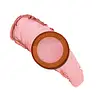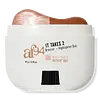Danessa Myricks Beauty Yummy Skin Blurring Balm Lowlighter Versus af94 It Takes 2 Bronzer + Highlighter Duo
What's inside
What's inside
 Key Ingredients
Key Ingredients

 Benefits
Benefits

 Concerns
Concerns

 Ingredients Side-by-side
Ingredients Side-by-side

Isohexadecane
EmollientC13-15 Alkane
SolventMagnesium Carbonate
AbsorbentIsododecane
EmollientDimethicone
EmollientSqualane
EmollientSynthetic Wax
AbrasiveSynthetic Candelilla Wax
EmollientSynthetic Fluorphlogopite
Kaolin
AbrasiveHydrolyzed Sodium Hyaluronate
Skin ConditioningLinum Usitatissimum Seed Oil
PerfumingZingiber Officinale Root Oil
MaskingLimnanthes Alba Seed Oil
Skin ConditioningTocopheryl Acetate
AntioxidantGlyceryl Behenate
EmollientMicrocrystalline Wax
Emulsion StabilisingPolyethylene
AbrasiveStearoxy Dimethicone
EmollientMica
Cosmetic ColorantSilica
AbrasiveTin Oxide
AbrasiveCI 77891
Cosmetic ColorantCI 77491
Cosmetic ColorantCI 77492
Cosmetic ColorantCI 16035
Cosmetic ColorantCI 42090
Cosmetic ColorantIsohexadecane, C13-15 Alkane, Magnesium Carbonate, Isododecane, Dimethicone, Squalane, Synthetic Wax, Synthetic Candelilla Wax, Synthetic Fluorphlogopite, Kaolin, Hydrolyzed Sodium Hyaluronate, Linum Usitatissimum Seed Oil, Zingiber Officinale Root Oil, Limnanthes Alba Seed Oil, Tocopheryl Acetate, Glyceryl Behenate, Microcrystalline Wax, Polyethylene, Stearoxy Dimethicone, Mica, Silica, Tin Oxide, CI 77891, CI 77491, CI 77492, CI 16035, CI 42090
Ethylhexyl Palmitate
EmollientHydrogenated Polyisobutene
EmollientCaprylic/Capric Triglyceride
MaskingSynthetic Wax
AbrasiveCI 77891
Cosmetic ColorantPolyglyceryl-2 Triisostearate
EmulsifyingSynthetic Fluorphlogopite
Kaolin
AbrasiveMicrocrystalline Wax
Emulsion StabilisingDimethicone/Vinyl Dimethicone Crosspolymer
Skin ConditioningCI 77491
Cosmetic ColorantSimmondsia Chinensis Seed Oil
EmollientCI 77492
Cosmetic ColorantLimnanthes Alba Seed Oil
Skin ConditioningPhenoxyethanol
PreservativeMacadamia Ternifolia Seed Oil
EmollientCI 77499
Cosmetic ColorantTin Oxide
AbrasiveTocopheryl Acetate
AntioxidantSilica
AbrasiveEthylhexylglycerin
Skin ConditioningEthylhexyl Palmitate, Hydrogenated Polyisobutene, Caprylic/Capric Triglyceride, Synthetic Wax, CI 77891, Polyglyceryl-2 Triisostearate, Synthetic Fluorphlogopite, Kaolin, Microcrystalline Wax, Dimethicone/Vinyl Dimethicone Crosspolymer, CI 77491, Simmondsia Chinensis Seed Oil, CI 77492, Limnanthes Alba Seed Oil, Phenoxyethanol, Macadamia Ternifolia Seed Oil, CI 77499, Tin Oxide, Tocopheryl Acetate, Silica, Ethylhexylglycerin
Ingredients Explained
These ingredients are found in both products.
Ingredients higher up in an ingredient list are typically present in a larger amount.
Ci 77491 is also hydrated iron III oxide. It's sole purpose is to give a red/pink hue to products.
Iron III oxides are classified as inorganic chemicals for coloring.
Synthetically created Ci 77491 is considered safer than those naturally found. This is because the synthetically created version may contain less impurities. Iron oxides are generally non-toxic and non-allergenic.
Learn more about CI 77491Ci 77492 is also hydrated iron III oxide. It's sole purpose is to give a yellow hue to products.
Iron III oxides are classified as inorganic chemicals for coloring.
Synthetically created Ci 77492 is considered safer than those naturally found. This is because the synthetically created version may contain less impurities. Iron oxides are generally non-toxic and non-allergenic.
Learn more about CI 77492Ci 77891 is a white pigment from Titanium dioxide. It is naturally found in minerals such as rutile and ilmenite.
It's main function is to add a white color to cosmetics. It can also be mixed with other colors to create different shades.
Ci 77891 is commonly found in sunscreens due to its ability to block UV rays.
Learn more about CI 77891Kaolin is a clay. It is used for oil control and to help minimize pores. Like other clays, kaolin has the ability to absorb excess sebum or oil. This can help clean out pores and mattify the skin.
Some types of kaolin may have exfoliating properties. When water is added to kaolin, it becomes a paste with small abrasive particles.
Most kaolin is a white color, but may be pink/orange/red depending on where it comes from.
The name 'kaolin' comes from a Chinese village named 'Gaoling'. Kaolin clay comes from rocks rich in kaolinite. Kaolinite, the mineral, has a silicate layered structure. Kaolinite is formed from chemical weathering of aluminum siilicate minerals.
Besides skincare, kaolin is commonly used to make glossy paper, in ceramics, toothpaste, and as medicine to soothe stomach issues.
Learn more about KaolinLimnanthes Alba Seed Oil is the oil extracted from the seeds of the meadowfoam plant. This oil is non-fragrant and is an emollient. As an emollient, meadowfoam seed oil helps soften and hydrate the skin.
Meadowfoam seed oil is stable and has a long shelf life due to its chemical structure. It has the highest concentration of stable fatty-acids among plant oils, preventing it from degrading once exposed to oxygen.
Due to the fatty acid content, this ingredient may not be fungal-acne safe.
Meadowfoam is native to California and Oregon.
Learn more about Limnanthes Alba Seed OilMicrocrystalline Wax is created by de-oiling petroleum. It is highly refined and purified before being added to cosmetics.
Microcrystalline Wax is used to enhance the texture and create even consistency. It helps stabilize a product by preventing ingredients from separating.
Silica, also known as silicon dioxide, is a naturally occurring mineral. It is used as a fine, spherical, and porous powder in cosmetics.
Though it has exfoliant properties, the function of silica varies depending on the product.
The unique structure of silica enhances the spreadability and adds smoothness, making it a great texture enhancer.
It is also used as an active carrier, emulsifier, and mattifier due to its ability to absorb excess oil.
In some products, tiny microneedles called spicules are made from silica or hydrolyzed sponge. When you rub them in, they lightly polish away dead skin layers and enhance the penetration of active ingredients.
Learn more about SilicaSynthetic Fluorphlogopite is the synthethic version of mica. It consists of fluorine, aluminum and silicate.
Synthetic Fluorphlogopite is used to add volume to products.
It is considered non-irritating on the skin.
Learn more about Synthetic FluorphlogopiteSynthetic Wax is created from fossil fuels such as natural gas. It is used to enhance texture, adjust pH, and as an occlusive.
It may also be used as an abrasive ingredient to exfoliate the skin.
Synthetic Wax may not be fungal acne safe.
Learn more about Synthetic WaxTin Oxide is an inorganic oxide used to add opacity and volume to a product. In nature, it is already found in mineral form. The main ore of tin is an opaque and shiny mineral called casseterite.
Tin Oxide helps remove translucency in a product, or make it more opaque. Besides adding opacity, tin oxide is used for bulking to add volume.
Tocopheryl Acetate is AKA Vitamin E. It is an antioxidant and protects your skin from free radicals. Free radicals damage the skin by breaking down collagen.
One study found using Tocopheryl Acetate with Vitamin C decreased the number of sunburned cells.
Tocopheryl Acetate is commonly found in both skincare and dietary supplements.
Learn more about Tocopheryl Acetate